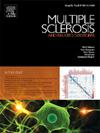High Intensity Interval Gait Training vs Moderate Intensity Continuous Gait training in Multiple Sclerosis: Impact on gait and balance
IF 2.9
3区 医学
Q2 CLINICAL NEUROLOGY
引用次数: 0
Abstract
Background and Purpose
High Intensity Interval Gait Training (HIIGT) has been shown to improve walking performance in neurologic conditions such as stroke but its impact on Multiple Sclerosis (MS) has not been well examined. The current standard of care for gait training for persons with MS (pwMS) is Moderate Intensity Continuous Gait Training (MICGT). The purpose of this study was to compare the impact of HIIGT to MICGT on gait and balance performance in pwMS.
Methods
Ambulatory pwMS were randomized into either a HIIGT or a MICGT condition. Participants in the HIIGT condition alternated 30 seconds of maximum effort fast walking with one minute of seated rest for 25 minutes. The MICGT group walked for 20 continuous minutes at a comfortable pace. Training was performed twice a week for 6 weeks. Primary outcome measures are the 6-minute walk test (6MWT) and the Functional Gait Assessment (FGA).
Results
To date 12 subjects (7 male, age 54.2, EDSS 3.4) have completed the study. 6MWT distances improved from 413 to 507 meters in the HIIGT group and from 445 to 473m in the MICGT group (MDC=88 meters). The HIIGT improved in FGA from 16.7 to 23.0 while the MICGT improved from 17.8 to 19.2.(MDC=6). Data collection is currently ongoing and is expected to conclude by 12/25. No adverse events were reported by either group.
Discussion
Both groups improved but the MDC for both primary outcome measures was only exceeded in the HIIGT group. Despite concerns about fatigue common in MS, the HIIGT sessions were well tolerated. Although the training was not specific to balance, subjects who underwent HIIGT improved balance performance, suggesting that the impact of HIIGT may extend beyond walking. These finding suggests that HIIGT may be a more effective physical therapy intervention for pwMS than the current standard of care.
多发性硬化症患者的高强度间歇步态训练与中等强度持续步态训练:对步态和平衡的影响
背景与目的高强度间歇步态训练(HIIGT)已被证明可改善中风等神经系统疾病患者的行走能力,但其对多发性硬化症(MS)的影响尚未得到充分研究。目前针对多发性硬化症患者(pwMS)的步态训练标准是中等强度持续步态训练(MICGT)。本研究旨在比较 HIIGT 和 MICGT 对步态和平衡能力的影响。在 HIIGT 条件下,参与者在 25 分钟内交替进行 30 秒钟的最大努力快走和一分钟的坐姿休息。MICGT 组则以舒适的步伐连续行走 20 分钟。训练每周进行两次,持续 6 周。主要结果指标为 6 分钟步行测试(6MWT)和功能步态评估(FGA)。结果迄今为止,已有 12 名受试者(7 名男性,年龄 54.2 岁,EDSS 3.4)完成了研究。HIIGT组的6MWT距离从413米提高到507米,MICGT组从445米提高到473米(MDC=88米)。HIIGT 组的 FGA 从 16.7 提高到 23.0,而 MICGT 组则从 17.8 提高到 19.2(MDC=6)。数据收集工作正在进行中,预计将于 12/25 日结束。两组患者均未出现不良反应。讨论两组患者的病情均有改善,但只有 HIIGT 组患者的主要疗效指标 MDC 均超过了预期。尽管多发性硬化症患者普遍存在疲劳问题,但对 HIIGT 训练的耐受性良好。虽然训练并非针对平衡,但接受 HIIGT 训练的受试者平衡能力有所提高,这表明 HIIGT 的影响可能超出了行走的范围。这些发现表明,HIIGT 可能是一种比目前的标准疗法更有效的物理治疗干预措施。
本文章由计算机程序翻译,如有差异,请以英文原文为准。
求助全文
约1分钟内获得全文
求助全文
来源期刊

Multiple sclerosis and related disorders
CLINICAL NEUROLOGY-
CiteScore
5.80
自引率
20.00%
发文量
814
审稿时长
66 days
期刊介绍:
Multiple Sclerosis is an area of ever expanding research and escalating publications. Multiple Sclerosis and Related Disorders is a wide ranging international journal supported by key researchers from all neuroscience domains that focus on MS and associated disease of the central nervous system. The primary aim of this new journal is the rapid publication of high quality original research in the field. Important secondary aims will be timely updates and editorials on important scientific and clinical care advances, controversies in the field, and invited opinion articles from current thought leaders on topical issues. One section of the journal will focus on teaching, written to enhance the practice of community and academic neurologists involved in the care of MS patients. Summaries of key articles written for a lay audience will be provided as an on-line resource.
A team of four chief editors is supported by leading section editors who will commission and appraise original and review articles concerning: clinical neurology, neuroimaging, neuropathology, neuroepidemiology, therapeutics, genetics / transcriptomics, experimental models, neuroimmunology, biomarkers, neuropsychology, neurorehabilitation, measurement scales, teaching, neuroethics and lay communication.
 求助内容:
求助内容: 应助结果提醒方式:
应助结果提醒方式:


